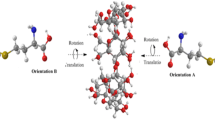Abstract
In this article, the interaction of formaldehyde (FA) with thymine is theoretically investigated by computational chemistry methods. The optimization geometries and vibrational frequencies of FA, thymine and three complexes between thymine and FA have been calculated by using the density functional theory and ab initio methods at the B3LYP/6-311G(d, p) and MP2/6-311G(d, p) levels. The NBO and AIM methods are used to analyse interaction as well. Conformers (A), (B) and (C) are cyclic structures with C–H***O and N–H***O hydrogen bonds on a common plane. The corrected complex interaction energies of cyclic structures (A), (B) and (C) at MP2/6-311G(d, p) levels are −38.41, −26.94 and −26.01 kJ/mol, respectively. The order of stability is (A) > (B) > (C).

Similar content being viewed by others
References
Friesner RA, Beachy MD (1998) Curr Opin Struct Biol 8:257. doi:10.1016/S0959-440X(98)80048-1
Ahmed D, Ludwik A, Guido M (2000) Chem Phys Lett 127:324
Takhashi O, Kohno Y, Saito K (2003) Chem Phys Lett 509:378
Liu T, Gu JD, Tian XJ, Zhu WL, Luo XM, Jiang HL et al (2001) J Phys Chem A 105:5431. doi:10.1021/jp003098c
Tarakeshwar P, Lee SJ, Lee JY, Kim KS (1999) J Phys Chem B 103:184. doi:10.1021/jp9833810
Reynisson J, Steenken S (2003) J Mol Struct Theochem 133:635
Meng F, Bu YC, Liu C (2002) Acta Chimi Sin 60:7
Skoufias DA, Mollinari C, Lacroix FB, Margolis R (2000) J Cell Biol 151:1575–1582. doi:10.1083/jcb.151.7.1575
Takigawa T, Horike T, Ohashi Y, Kataoka H, Wang DH, Kira S (2004) Environ Toxicol 19:280–290. doi:10.1002/tox.20035
Malek FA, Moritz KU, Fanghang J (2003) Ann Anat 185:277–285. doi:10.1016/S0940-9602(03)80040-7
Zarasiz I, Kus I, Akpolat N, Songur A, Ogeturk M (2006) Cell Biochem Funct 24:237–244. doi:10.1027/cbf.1204
Nalivaiko E, De Pasquale CG, Blessing WW (2003) Auton Neurosci 105:101–104. doi:10.1016/S1566-0702(03)00048-1
Mautz WJ (2003) Environ Res 92:14–26. doi:10.1016/S0013-9351(02)00024-5
Tyihak E, Bocsi J, Timar F (2001) Cell Prolif 34:135–141. doi:10.1046/j.1365-2184.2001.00206.x
Emri G, Schaefer D, Held B, Herbst C, Zieger W, Horkay I (2004) Exp Dermatol 13:305–315. doi:10.1111/j.0906-6705.2004.00157.x
Lin Z, Luo W, Li H et al (2005) Toxicol Lett 1592:134–143. doi:10.1016/j.toxlet.2005.05.003
Becker AD, Rauk A (1977) Phys Rev 46:1
Lee C, Yang W, Parr RG (1988) Phys Rev B 37:785. doi:10.1103/PhysRevB.37.785
Stevens PJ, Devlin FJ, Chablowski CF, Frisch MJ (1994) J Phys Chem 98:11623. doi:10.1021/j100096a001
Biegler-Konig F, Schonbohm J, Bayles D (2001) J Comput Chem 22:545. doi:10.1002/1096-987X(20010415)22:5<545::AID-JCC1027>3.0.CO;2-Y
Boys SF, Bernardi F (1970) Mol Phys 19:553. doi:10.1080/00268977000101561
Bader RFW (1990) Atoms in molecules. A quantum theory. Clarendon, Oxford
Reed AE, Curtiss LA, Weinhold F (1988) Chem Rev 88:899. doi:10.1021/cr00088a005
Frisch MJ, Trucks GW, Schlegel HB, Scuseria GE (2003) Gaussian 03, revision B.03. Gaussian Inc., Pittsburgh
Xu X, Goddard WAIII (2004) Proc Natl Acad Sci USA 101:2673. doi:10.1073/pnas.0308730100
Rappe AK, Bernstein ER (2000) J Phys Chem A 104:6117. doi:10.1021/jp0008997
Gur’yanova N, Gol’dshtein IP, Romm IP (1975) The donor–acceptor bond. Wiley, New York
Garura C, Frontera A, Quiñonero D, Ballester P, Costa A, Deyá PM (2003) Chem Phys Chem 4:1344. doi:10.1002/cphc.200300886
Schwenke DW, Truhlar DG (1985) J Chem Phys 82:2418. doi:10.1063/1.448335
Gutowski M, Chalasinski G (1993) J Chem Phys 98:4728. doi:10.1063/1.465106
Author information
Authors and Affiliations
Corresponding author
Rights and permissions
About this article
Cite this article
Yang, C., Wang, H. Ab initio and DFT theory studies of interaction of thymine with formaldehyde. Struct Chem 19, 843–847 (2008). https://doi.org/10.1007/s11224-008-9374-z
Received:
Accepted:
Published:
Issue Date:
DOI: https://doi.org/10.1007/s11224-008-9374-z




